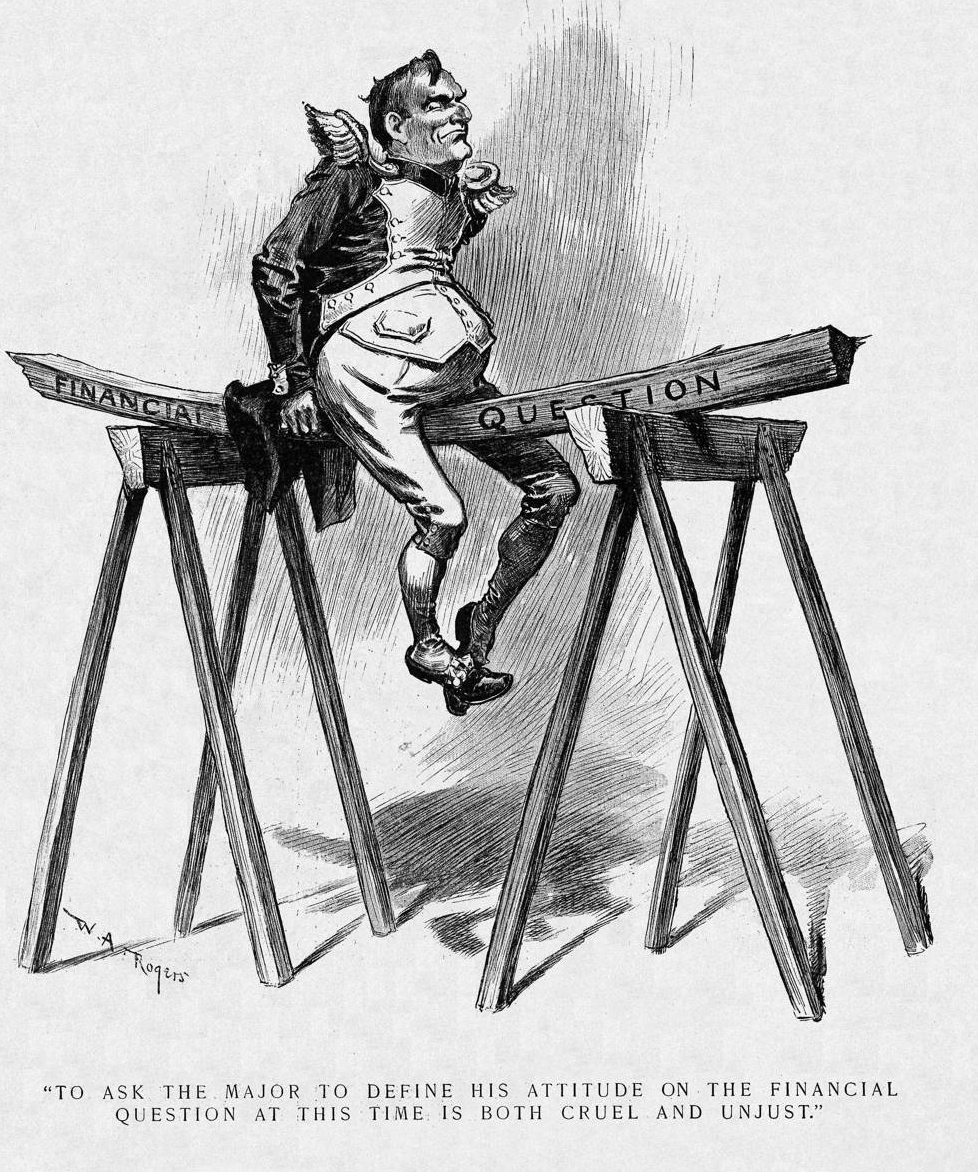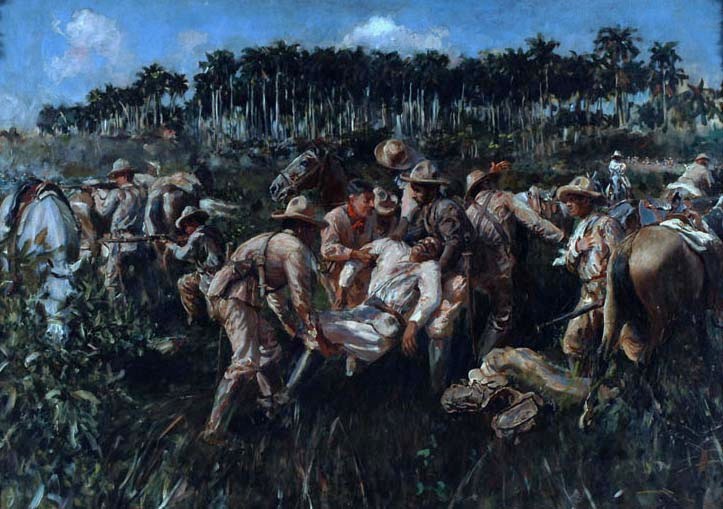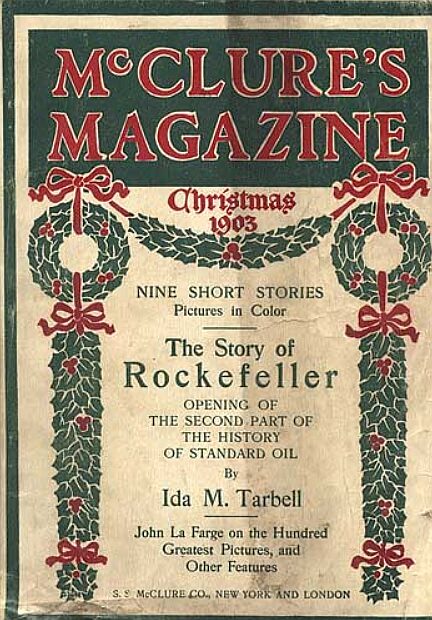|
Presidency Of William McKinley
The presidency of William McKinley began on March 4, 1897, when William McKinley was inaugurated and ended September 14, 1901, upon his assassination. A longtime Republican, McKinley is best known for conducting the successful Spanish–American War (1898), freeing Cuba from Spain; taking ownership of the Republic of Hawaii; and purchasing the Philippines, Guam and Puerto Rico. It includes the 1897 Dingley Tariff which raised rates to protect manufacturers and factory workers from foreign competition, and the Gold Standard Act of 1900 that rejected free silver inflationary proposals. Rapid economic growth and a decline in labor conflict marked the presidency and he was easily reelected in a landslide. The 25th United States president, McKinley took office following the 1896 presidential election, in which he defeated Democrat William Jennings Bryan. In the campaign, McKinley advocated "sound money", promised that high tariffs would restore prosperity, and denounced Bryan as a ... [...More Info...] [...Related Items...] OR: [Wikipedia] [Google] [Baidu] |
Assassination Of William McKinley
William McKinley, the 25th president of the United States, was shot on the grounds of the Pan-American Exposition at the Temple of Music in Buffalo, New York, on September 6, 1901, six months into his second term. He was shaking hands with the public when anarchist Leon Czolgosz shot him twice in the abdomen. McKinley died on September 14 of gangrene caused by the wounds. He was the third American president to be assassinated, following Abraham Lincoln in 1865 and James A. Garfield in 1881. McKinley enjoyed meeting the public and was reluctant to accept the security available to his office. Secretary to the President George B. Cortelyou feared that an assassination attempt would take place during a visit to the Temple of Music and took it off the schedule twice, but McKinley restored it each time. Czolgosz had lost his job during the economic Panic of 1893 and turned to anarchism, a political philosophy adhered to by recent assassins of foreign leaders. He regarded McKinle ... [...More Info...] [...Related Items...] OR: [Wikipedia] [Google] [Baidu] |
Free Silver
Free silver was a major economic policy issue in the United States in the late 19th-century. Its advocates were in favor of an expansionary monetary policy featuring the unlimited coinage of silver into money on-demand, as opposed to strict adherence to the more carefully fixed money supply implicit in the gold standard. Free silver became increasingly associated with populism, unions, and the fight of ordinary Americans against the bankers and monopolists, and the robber baron (industrialist), robber barons of the Gilded Age capitalism era and was referred to as the "People's Money". Supporters of an important place for silver in a bimetallism, bimetallic money system making use of both silver and gold, called "Silverites", sought coinage of silver dollars at a fixed weight ratio of 16-to-1 against dollar coins made of gold. Because the actual price ratio of the two metals was substantially higher in favor of gold at the time, most economists warned that the less valuable silver ... [...More Info...] [...Related Items...] OR: [Wikipedia] [Google] [Baidu] |
Historical Rankings Of Presidents Of The United States
In political studies, surveys have been conducted in order to construct historical rankings of the success of the presidents of the United States. Ranking systems are usually based on surveys of academic historians and political scientists or popular opinion. The scholarly rankings focus on presidential achievements, leadership qualities, failures and faults. Popular-opinion polls typically focus on recent or well-known presidents. General findings Abraham Lincoln, Franklin D. Roosevelt, and George Washington are most often listed as the three highest-rated presidents among historians. More recent presidents such as Ronald Reagan and Bill Clinton are often rated among the greatest in public opinion polls, but generally do not rank as highly among presidential scholars and historians. Because William Henry Harrison (31 days) and James A. Garfield (200 days, incapacitated after 119 days) both died shortly after taking office, they are often omitted from presidential rankings. ... [...More Info...] [...Related Items...] OR: [Wikipedia] [Google] [Baidu] |
Panic Of 1893
The Panic of 1893 was an economic depression in the United States that began in 1893 and ended in 1897. It deeply affected every sector of the economy, and produced political upheaval that led to the political realignment of 1896 and the presidency of William McKinley. Causes The Panic of 1893 has been traced to many causes, one of those points to Argentina; investment was encouraged by the Argentine agent bank, Baring Brothers. However, the 1890 wheat crop failure and a failed coup in Buenos Aires ended further investments. In addition, speculations in South African and Australian properties also collapsed. Because European investors were concerned that these problems might spread, they started a run on gold in the U.S. Treasury. Specie was considered more valuable than paper money; when people were uncertain about the future, they hoarded specie and rejected paper notes.Nelson, Scott Reynolds. 2012. A Nation of Deadbeats. New York: Alfred Knopf, p. 189. During the Gi ... [...More Info...] [...Related Items...] OR: [Wikipedia] [Google] [Baidu] |
Territory Of Hawaii
The Territory of Hawaii or Hawaii Territory ( Hawaiian: ''Panalāʻau o Hawaiʻi'') was an organized incorporated territory of the United States that existed from April 30, 1900, until August 21, 1959, when most of its territory, excluding Palmyra Island, was admitted to the United States as the 50th U.S. state, the State of Hawaii. The Hawaii Admission Act specified that the State of Hawaii would not include Palmyra Island, the Midway Islands, Kingman Reef, and Johnston Atoll, which includes Johnston (or Kalama) Island and Sand Island. On July 4, 1898, the United States Congress passed the Newlands Resolution authorizing the U.S. annexation of the Republic of Hawaii, and five weeks later, on August 12, Hawaii became a U.S. territory. In April 1900 Congress approved the Hawaiian Organic Act which organized the territory. United States Public Law 103-150 adopted in 1993, (informally known as the Apology Resolution), acknowledged that "the overthrow of the Kingdom of Hawaii ... [...More Info...] [...Related Items...] OR: [Wikipedia] [Google] [Baidu] |
Hawaii
Hawaii ( ; haw, Hawaii or ) is a state in the Western United States, located in the Pacific Ocean about from the U.S. mainland. It is the only U.S. state outside North America, the only state that is an archipelago, and the only state geographically located within the tropics. Hawaii comprises nearly the entire Hawaiian archipelago, 137 volcanic islands spanning that are physiographically and ethnologically part of the Polynesian subregion of Oceania. The state's ocean coastline is consequently the fourth-longest in the U.S., at about . The eight main islands, from northwest to southeast, are Niihau, Kauai, Oahu, Molokai, Lānai, Kahoolawe, Maui, and Hawaii—the last of these, after which the state is named, is often called the "Big Island" or "Hawaii Island" to avoid confusion with the state or archipelago. The uninhabited Northwestern Hawaiian Islands make up most of the Papahānaumokuākea Marine National Monument, the United States' largest protected ... [...More Info...] [...Related Items...] OR: [Wikipedia] [Google] [Baidu] |
Cuba
Cuba ( , ), officially the Republic of Cuba ( es, República de Cuba, links=no ), is an island country comprising the island of Cuba, as well as Isla de la Juventud and several minor archipelagos. Cuba is located where the northern Caribbean Sea, Gulf of Mexico, and Atlantic Ocean meet. Cuba is located east of the Yucatán Peninsula (Mexico), south of both the American state of Florida and the Bahamas, west of Hispaniola ( Haiti/Dominican Republic), and north of both Jamaica and the Cayman Islands. Havana is the largest city and capital; other major cities include Santiago de Cuba and Camagüey. The official area of the Republic of Cuba is (without the territorial waters) but a total of 350,730 km² (135,418 sq mi) including the exclusive economic zone. Cuba is the second-most populous country in the Caribbean after Haiti, with over 11 million inhabitants. The territory that is now Cuba was inhabited by the Ciboney people from the 4th millennium BC with the Gua ... [...More Info...] [...Related Items...] OR: [Wikipedia] [Google] [Baidu] |
Cuban War Of Independence
The Cuban War of Independence (), fought from 1895 to 1898, was the last of three liberation wars that Cuba fought against Spain, the other two being the Ten Years' War (1868–1878) and the Little War (1879–1880). The final three months of the conflict escalated to become the Spanish–American War, with United States forces being deployed in Cuba, Puerto Rico, and the Philippine Islands against Spain. Historians disagree as to the extent that United States officials were motivated to intervene for humanitarian reasons but agree that yellow journalism exaggerated atrocities attributed to Spanish forces against Cuban civilians. Background During the years 1879–1888 of the so-called "Rewarding Truce", lasting for 17 years from the end of the Ten Years' War in 1878, there were fundamental social changes in Cuban society. With the abolition of slavery in October 1886, freedmen joined the ranks of farmers and the urban working class. The economy could no longer sustain itse ... [...More Info...] [...Related Items...] OR: [Wikipedia] [Google] [Baidu] |
Progressive Era
The Progressive Era (late 1890s – late 1910s) was a period of widespread social activism and political reform across the United States focused on defeating corruption, monopoly, waste and inefficiency. The main themes ended during American involvement in World War I (1917–1918) while the waste and efficiency elements continued into the 1920s. Progressives sought to address the problems caused by rapid industrialization, urbanization, immigration, and political corruption; and by the enormous concentration of industrial ownership in monopolies. They were alarmed by the spread of slums, poverty, and what they perceived as the "exploitation" of labor. Multiple overlapping progressive movements fought perceived social, political and economic ills by advancing democracy, scientific methods, professionalism and efficiency; regulating businesses, protecting the natural environment, and improving working conditions in factories and living conditions of the urban poor. Sprea ... [...More Info...] [...Related Items...] OR: [Wikipedia] [Google] [Baidu] |
Fourth Party System
The Fourth Party System is the term used in political science and history for the period in American political history from about 1896 to 1932 that was dominated by the Republican Party, except the 1912 split in which Democrats captured the White House and held it for eight years. American history texts usually call the period the Progressive Era. The concept was introduced under the name "System of 1896" by E. E. Schattschneider in 1960, and the numbering scheme was added by political scientists in the mid-1960s. The period featured a transformation from the issues of the Third Party System, which had focused on the American Civil War, Reconstruction, race, and monetary issues. The era began in the severe depression of 1893 and the extraordinarily intense election of 1896. It included the Progressive Era, World War I, and the start of the Great Depression. The Great Depression caused a realignment that produced the Fifth Party System, dominated by the Democratic New Deal Coal ... [...More Info...] [...Related Items...] OR: [Wikipedia] [Google] [Baidu] |
Class Conflict
Class conflict, also referred to as class struggle and class warfare, is the political tension and economic antagonism that exists in society because of socio-economic competition among the social classes or between rich and poor. The forms of class conflict include direct violence such as wars for resources and cheap labor, assassinations or revolution; indirect violence such as deaths from poverty and starvation, illness and unsafe working conditions; and economic coercion such as the threat of unemployment or the withdrawal of investment capital (capital flight); or ideologically, by way of political literature. Additionally, political forms of class warfare include legal and illegal lobbying, and bribery of legislators. The social-class conflict can be direct, as in a dispute between labour and management such as an employer's industrial lockout of their employees in effort to weaken the bargaining power of the corresponding trade union; or indirect such as a workers' sl ... [...More Info...] [...Related Items...] OR: [Wikipedia] [Google] [Baidu] |
Hard Currency
In macroeconomics, hard currency, safe-haven currency, or strong currency is any globally traded currency that serves as a reliable and stable store of value. Factors contributing to a currency's ''hard'' status might include the stability and reliability of the respective state's legal and bureaucratic institutions, level of corruption, long-term stability of its purchasing power, the associated country's political and fiscal condition and outlook, and the policy posture of the issuing central bank. Safe haven currency is defined as a currency which behaves like a hedge for a reference portfolio of risky assets conditional on movements in global risk aversion. Conversely, a weak or soft currency is one which is expected to fluctuate erratically or depreciate against other currencies. Softness is typically the result of weak legal institutions and/or political or fiscal instability. History The paper currencies of some developed countries have earned recognition as hard curr ... [...More Info...] [...Related Items...] OR: [Wikipedia] [Google] [Baidu] |




.jpg)



